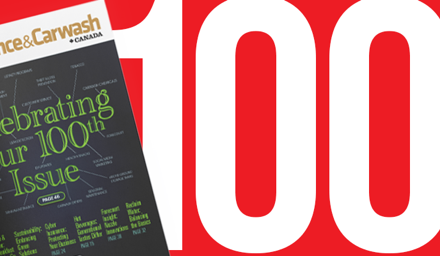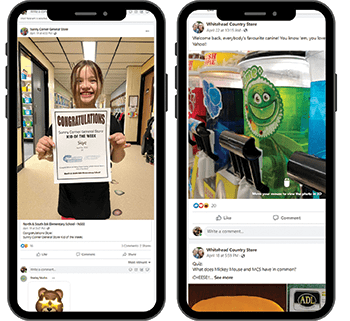
Digital Communication

Leveraging Online Channels to Increase Likes, Followers, Shares, and SALES!
By Meline Beach
From websites and videos to social media, email blasts, and text messaging, many organizations use a range of online channels to communicate with current and prospective customers. As a viable business, C&G retailers should be no different.
According to Digital Marketing Strategist Donna Sauve, it’s very important for small to medium-sized businesses to establish an online presence. “Not only does it show creditability, but if someone cannot find your business online it makes them question your reliability and even legitimacy of your business.” Sauve adds, “showing up in an online search is how potential customers find the products and services they are looking for and allows businesses to connect with consumers, increase brand awareness and be found. It is a great opportunity to broaden their reach and communicate with customers.”
According to a Salesforce survey, 85 per cent of consumers conduct research before they make a purchase online, and among the most used channels for research are websites (74 per cent) and social media (38 per cent).
Younger consumers, especially, connect to their favourite brands online as a way of staying informed on the latest news and special offers. If you want to appeal to your customers, reach out to them in ways in which that grab their attention. Digital communication is here to stay. If you have not already created an online presence, the following five tips will guide you through the process.
1. Dedicated resource
– Identify someone on your team who is either technology savvy or a quick learner that is eager to expand their skillset. Either way, someone on your team must be responsible and dedicated to posting on your online channels, including any website updates. Once identified, be sure to keep this person in the loop on any news, promotions, and general information that would be of interest to your target audience.
Ping Tan from Tanny’s convenience store, located in Matheson, Ontario, relied on her daughter to manage her store’s Facebook page and website. But now that she is away at school, Tan has little time to dedicate to these channels regularly. “I typically make a post every two to three months,” says Tan. “Surely not frequent enough based on today’s standards.” Her store’s Facebook page has 535 likes and 562 followers with 17 people checked in. Tan also leverages a chalkboard by the grab-and-go cooler to communicate various in-store promotions, as well as an in-store TV screen that displays her store’s foodservice menu. As her store is easily accessible from the town’s main highway, Tan is also interested in renting two billboards along both sides of the major highway to attract more attention from travellers.
2. Time commitment
– We live busy lives and the internet moves at a fast pace. It is important to commit the time to tend to your communication channels, which could be as little as 15 to 30 minutes a day. If you know your specials or promotions ahead of time you can create content and schedule it to appear live in advance. This will help in alleviating daily stresses. You can display your Twitter, Facebook, Pinterest, and Instagram accounts on your website, which means that any posts featured on those platforms are also visible on your website. This helps to keep your website content fresh and accessible to clients who frequent your website over social media. Your website, as well as in-store communications, should let your audience know of your social channels by displaying their icons with a little encouragement that reads, “Follow us on…”
Don Noble of Whitehead Country Store in New Brunswick maintains his store’s Facebook page as a main method of communication, apart from word of mouth. “A more frequent focus would be more effective but with time constraints it becomes more random than it should be.” Whitehead Country Store’s Facebook page has 802 likes, 831 followers, and 19 check-ins. Many of its posts are shared with other networks which expands the store’s reach to a wider audience.
If committing the time to manage your social media is challenging, Sauve shares two options for consideration. “You can either work with a social media management company, which typically charges monthly, or you can hire a freelancer, who usually charges by the hour,” says Sauve. “Social media management companies can start as low as $300 per month or if you decide to use a freelancer the amount they charge will usually depend heavily on how much experience they bring to the table, and could start as low as $25 to $35 an hour.”
3. Quality content
– Determine your goals. Is it to increase foot traffic to your store? Increase sales of a particular item? Capture your audience’s attention by sharing information that appeals to them – your store’s features and benefits, including specials, promotions, and new items. Create a content calendar of planned posts and keep them relevant. What specials do you have in store? What new items are up for sale? What discounts might be available in the near term? Quality content is specific to the needs and interests of your target audience. Use your words wisely (there is a reason Twitter has a 280-character limit), keep it conversational and error-free. Photos and videos are instrumental in garnering attention. Consider photos of products, food, promotions, and events. Photos and videos of people make it relatable. And remember, multiple points of contact are key so don’t shy away from posting your content on different channels – be it Facebook, Twitter, Instagram, TikTok, or your website. Quality content on your social channels and website allows you to make the best first impression with your target audience.
“As an independent c-store retailer, we have creative freedom as to what and how to communicate with our customers,” says Noble, who believes in being a good corporate citizen and leader within his community. “We communicate new products, community events, charity drives, and goodwill articles, such as lost pets.”
4. Frequency
– While websites do not necessarily require daily updates, social media travels fast. Consider daily posts if your content warrants it. Otherwise, aim for two posts per week at a minimum to maintain momentum and keep your audience engaged. Besides your original content, there are plenty of “hallmark” holidays that work as posts as well, such as Mother’s Day, Valentine’s Day, Canada Day, and Christmas – all of which serve as opportunities to invite customers to your store to shop, often for last-minute items. Remember the diversity of your target audience and be mindful of cultural themes.
“We just started communicating with our customers online,” says Kathy Astle of Sunny Corner General Store. “We started slow but are now making it a priority to post every week. The New Brunswick-based store has 799 likes and 817 followers on Facebook. “We let people know what’s new in-store and what promotions are coming up,” says Kathy, who also leverages a traditional message board that displays any in-store specials.
5. Engagement
– Monitor your communication channels and respond to questions or comments in a timely manner. You can also create polls and ask your audience questions online, which enables you to improve your customer insight. Satisfied customers are more likely to share their experiences online, which promotes your brand and could influence other people’s opinions as well, and bring in new customers. Note, that the reverse is also a risk. Customers can share negative experiences online as well, which could detract customers. Be mindful that your online interactions reflect your customer service style. You’ll want to get it right and keep it positive and timely. Your social media channels are accessible on your smartphone, making it easy to stay current. Realizing that your workday is busy, make a point of checking your communication channels at least once per day, on break or at the end of a shift.
Sauve also advocates that C&G retailers leverage Google My Business (GMB) as an often untapped valuable and free resource. Not only is it used to manage your online reviews and online reputation but it can also be used to share information about your business, products, and services, as well as online content. GMB can increase your Google ranking, and help your business get found quick and easy in Google search with a map of your exact location. “Getting started is as easy as setting up a Google account and claiming your business listing,” says Sauve.
Managed internally or outsourced, your website and social media channels represent your brand and serve as an opportunity to attract and engage customers. Done right, your return on investment of time and resources will pay off tremendously. It’s all in the numbers…. From likes, followers, and shares to ultimately sales.
Meline Beach is a Toronto-based communications practitioner and frequent contributor to Convenience & Carwash Canada. In addition to freelance writing, Meline provides communications and public relations support to businesses across Canada. She can be reached at www.mlbcomms.ca




































